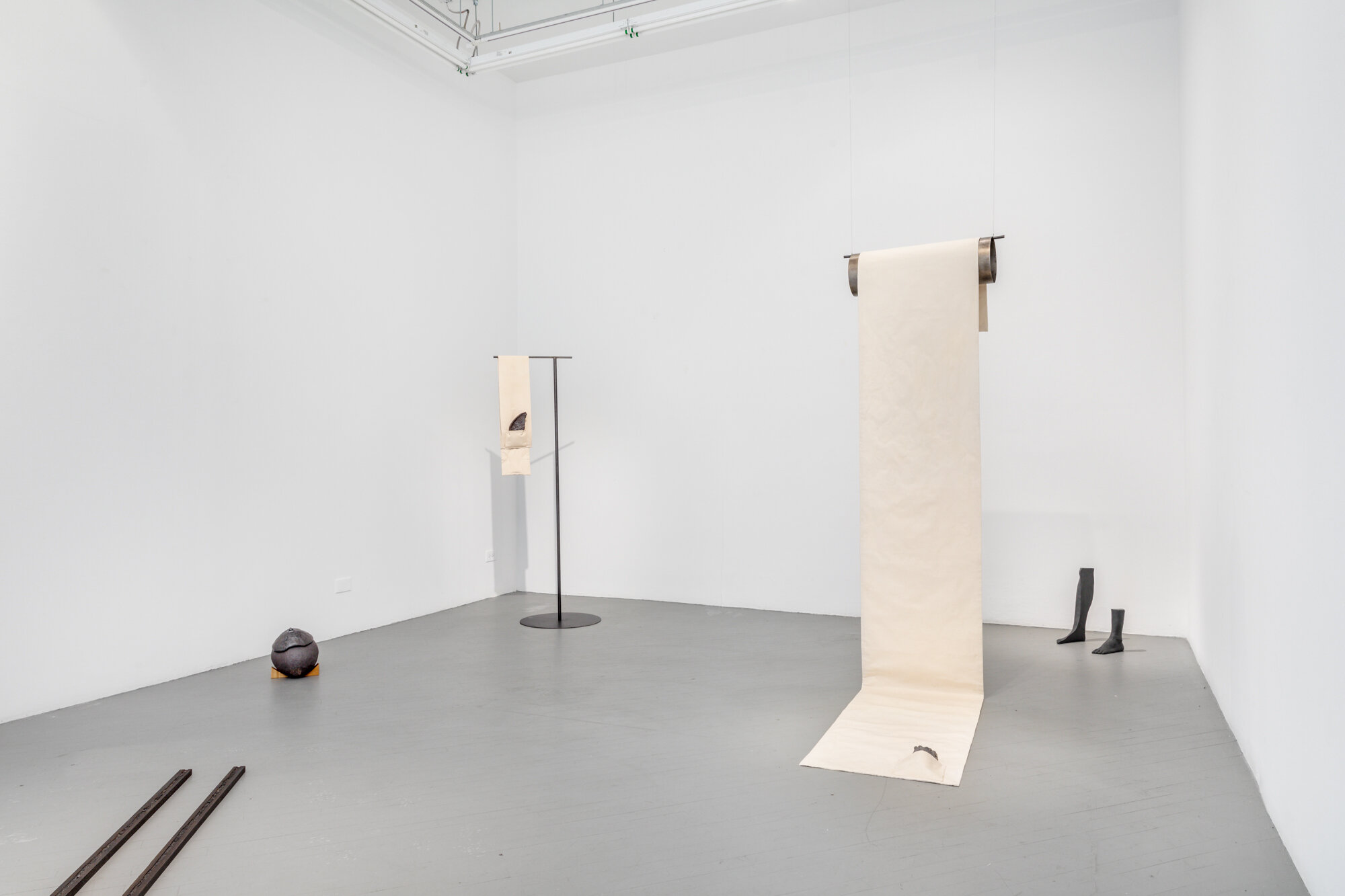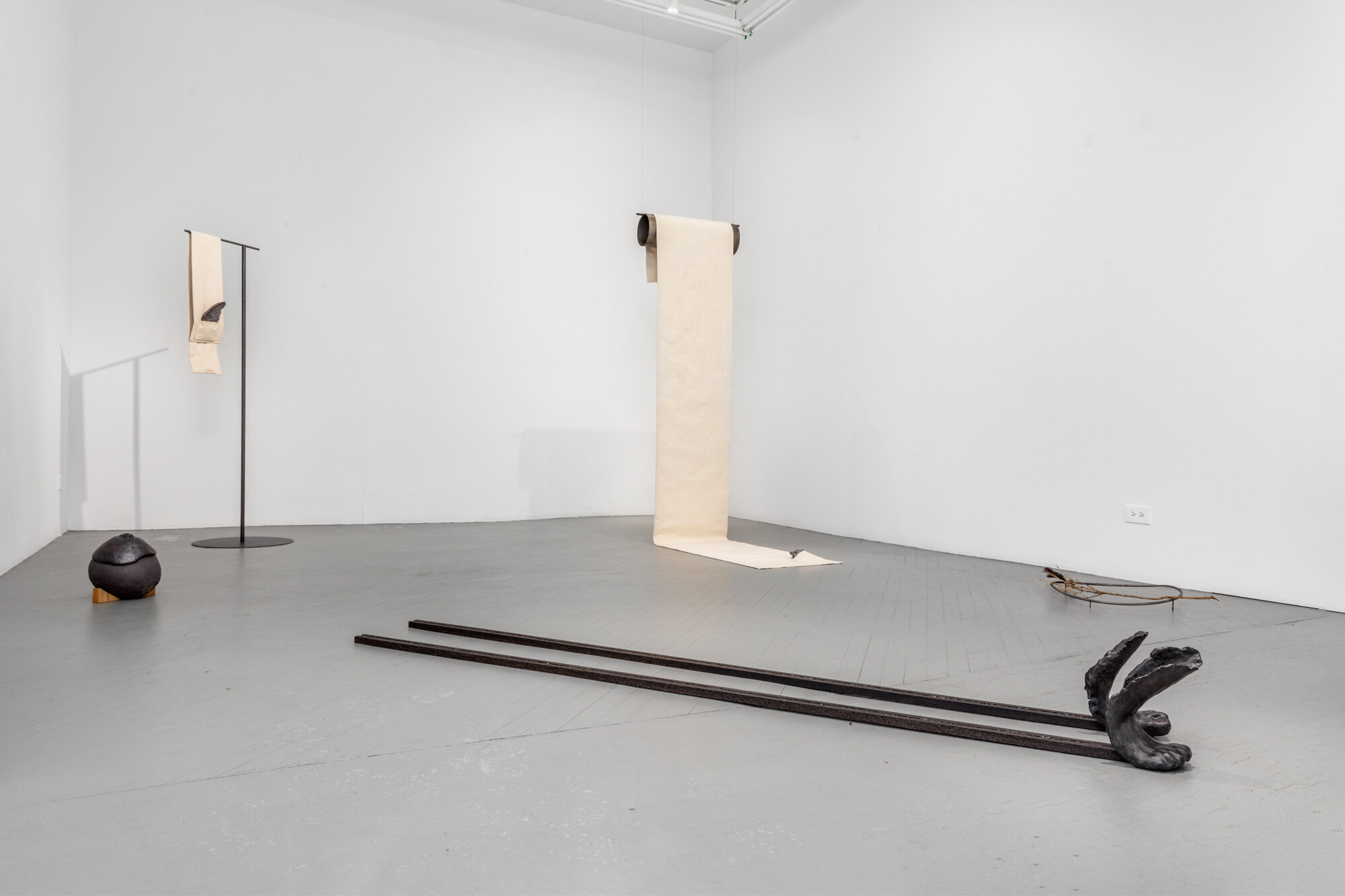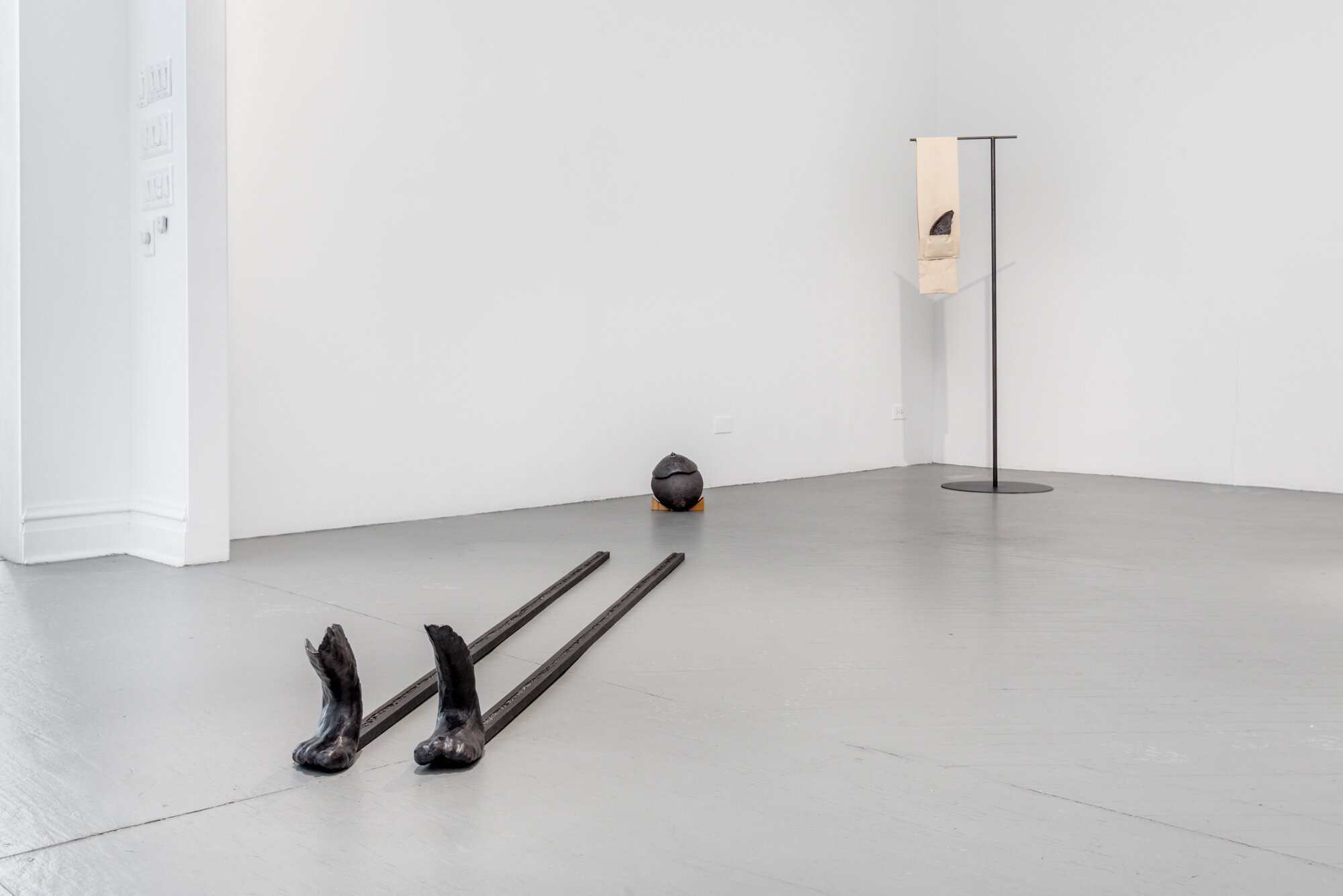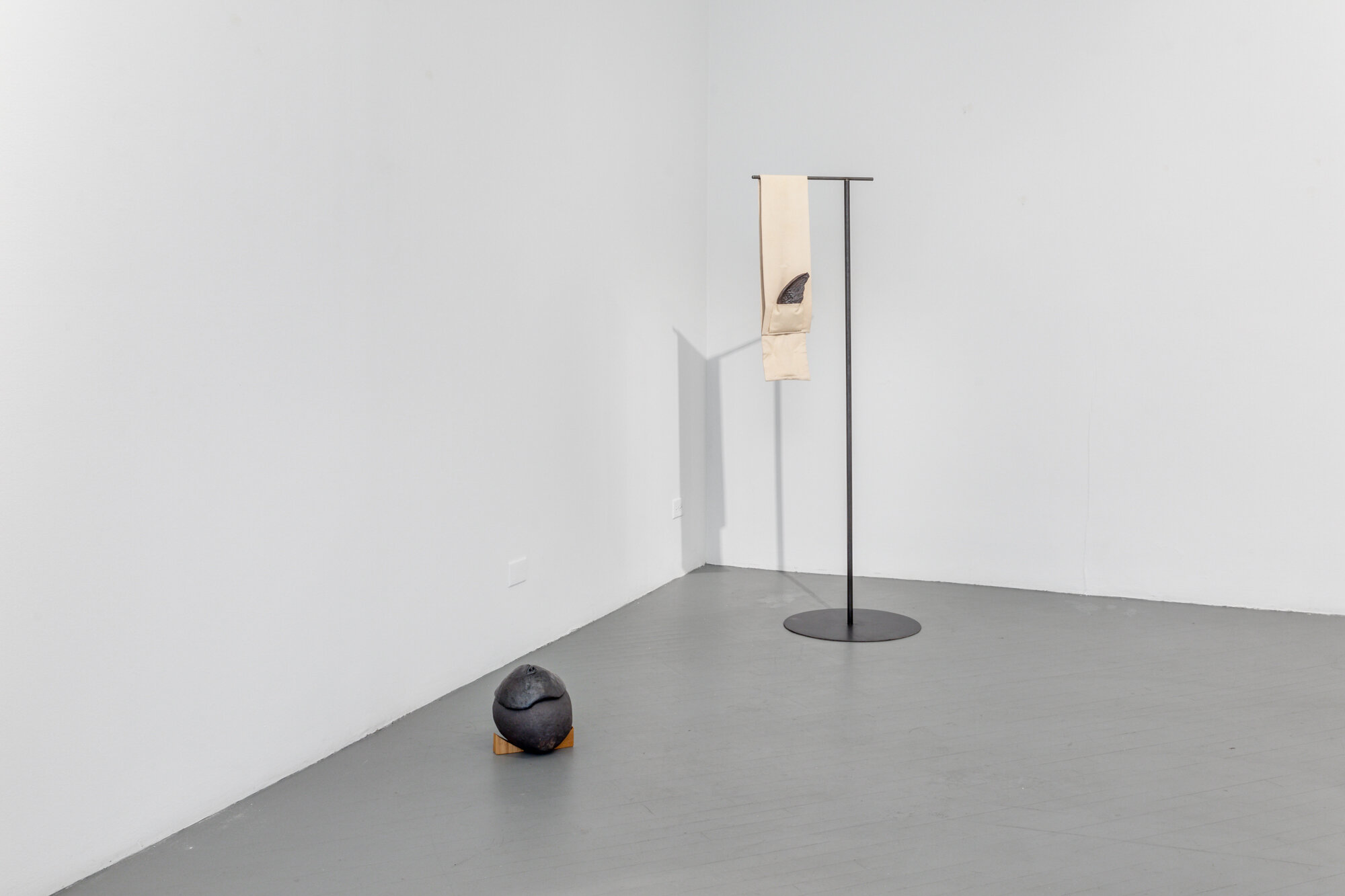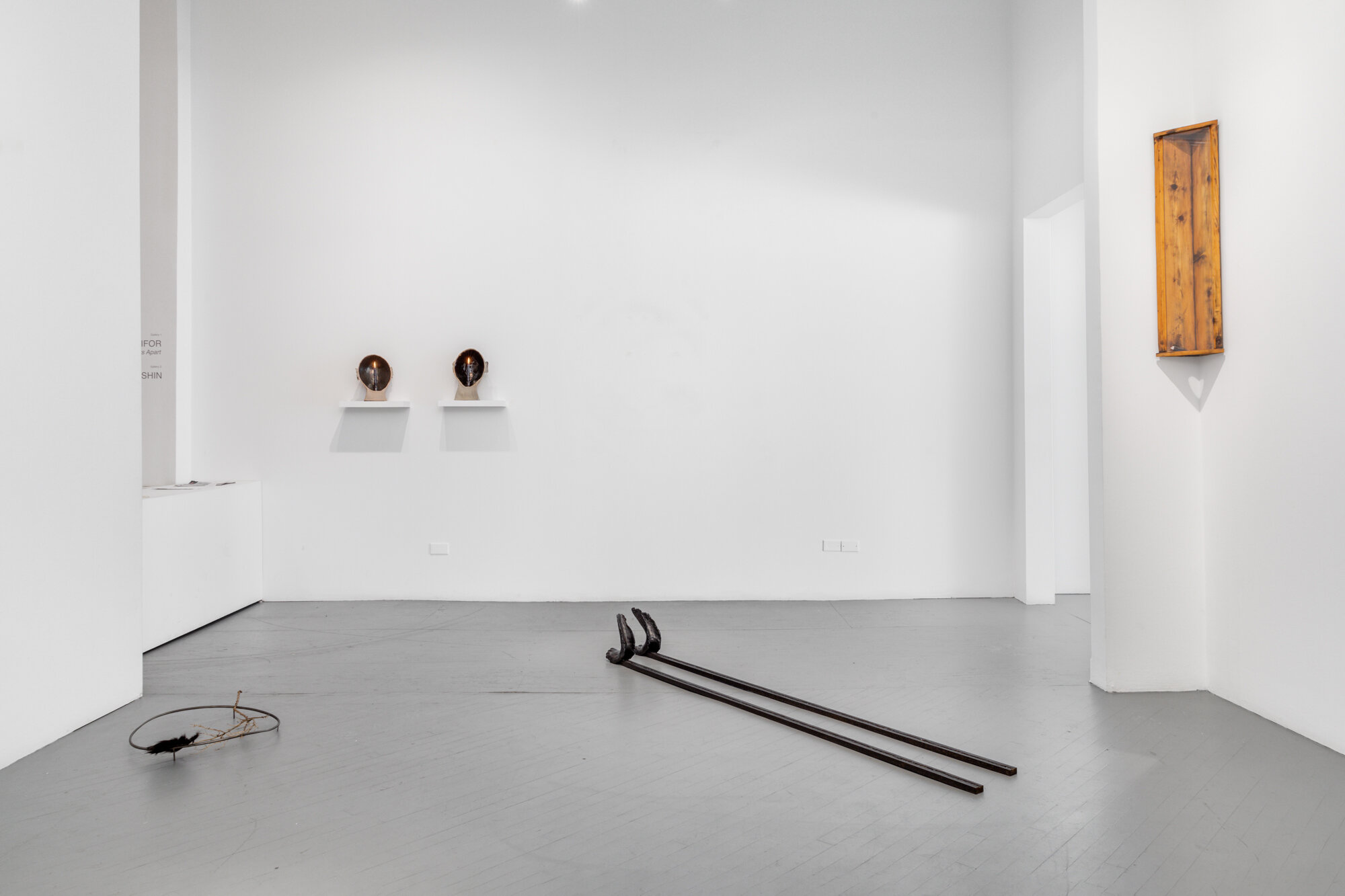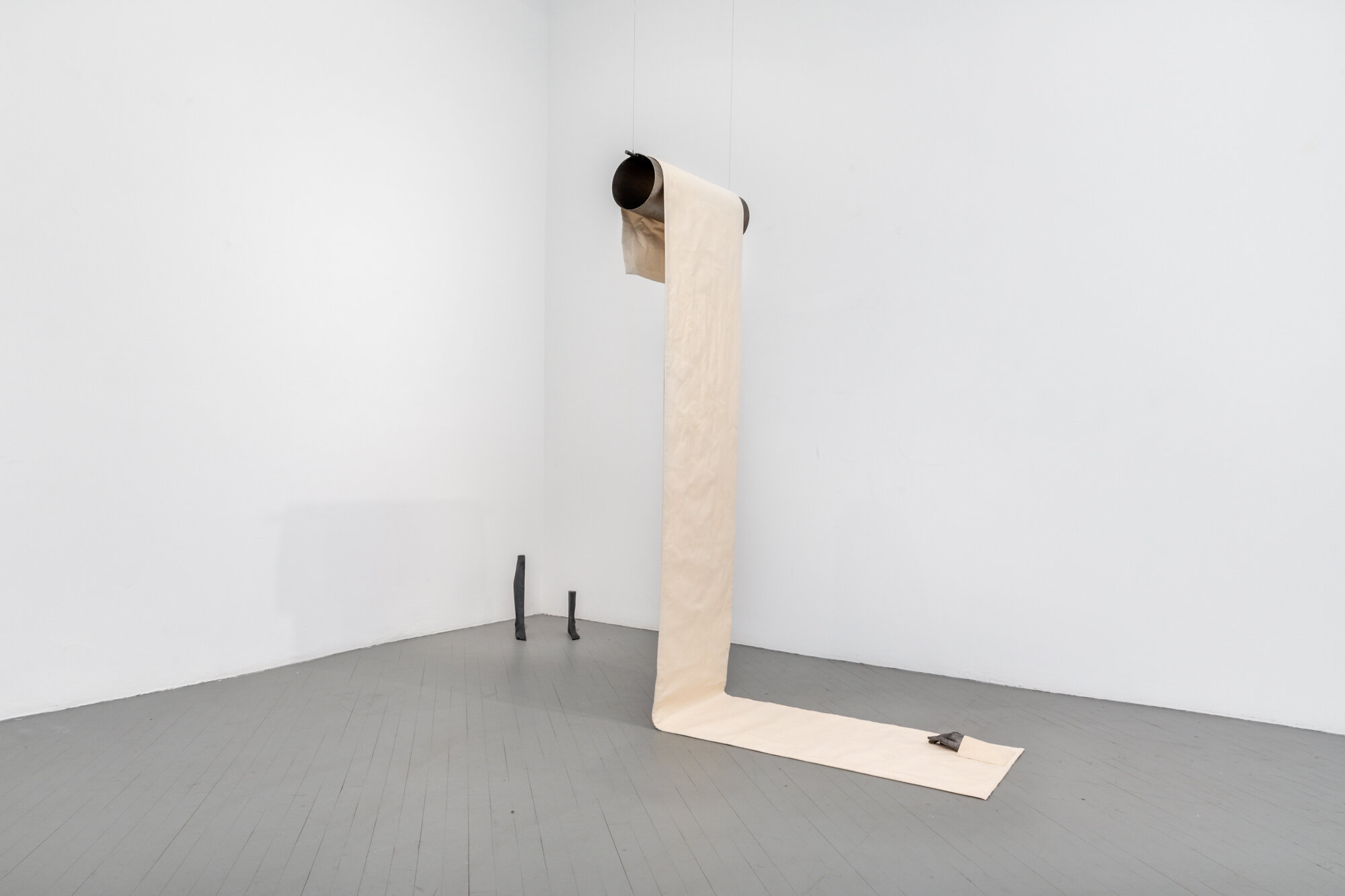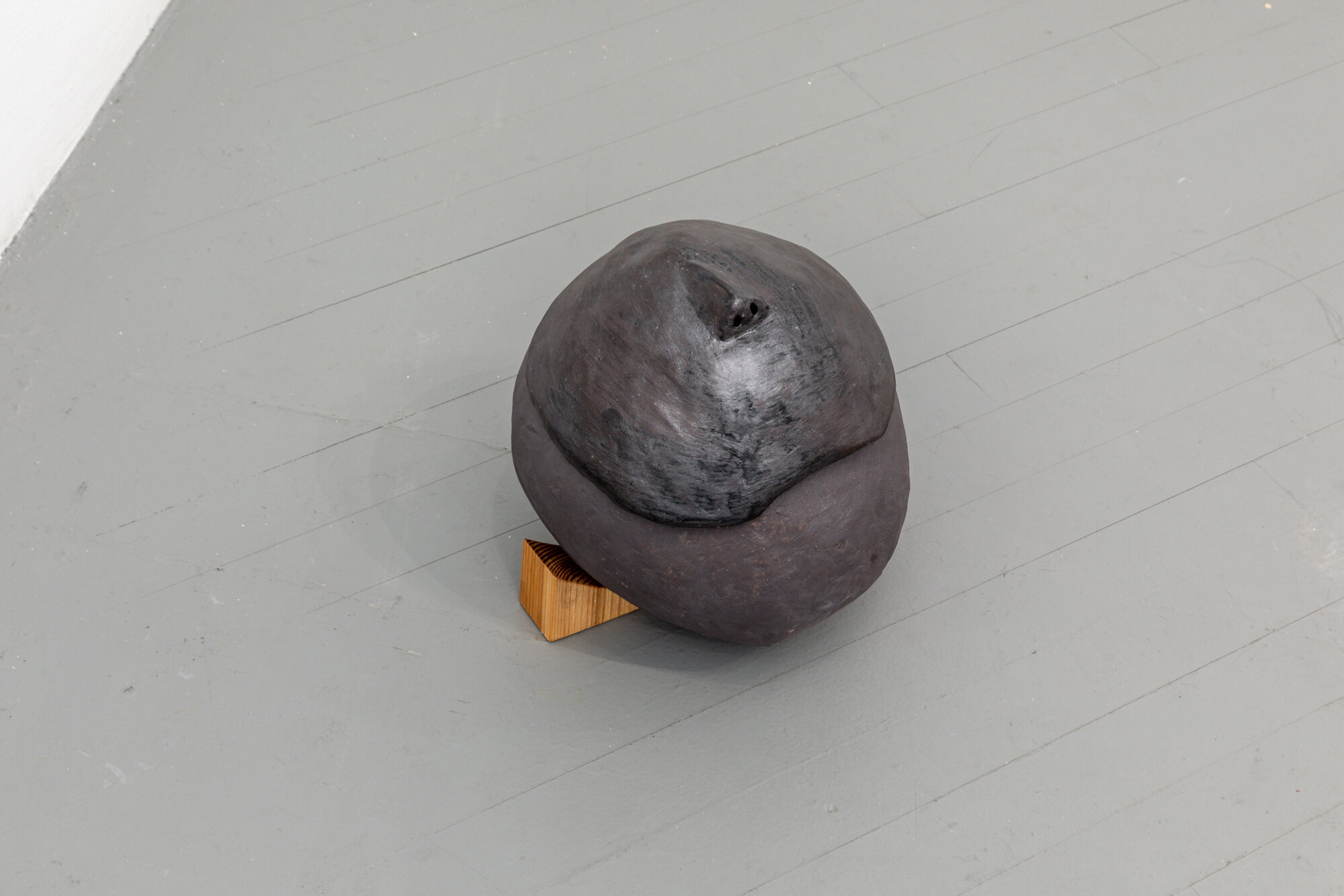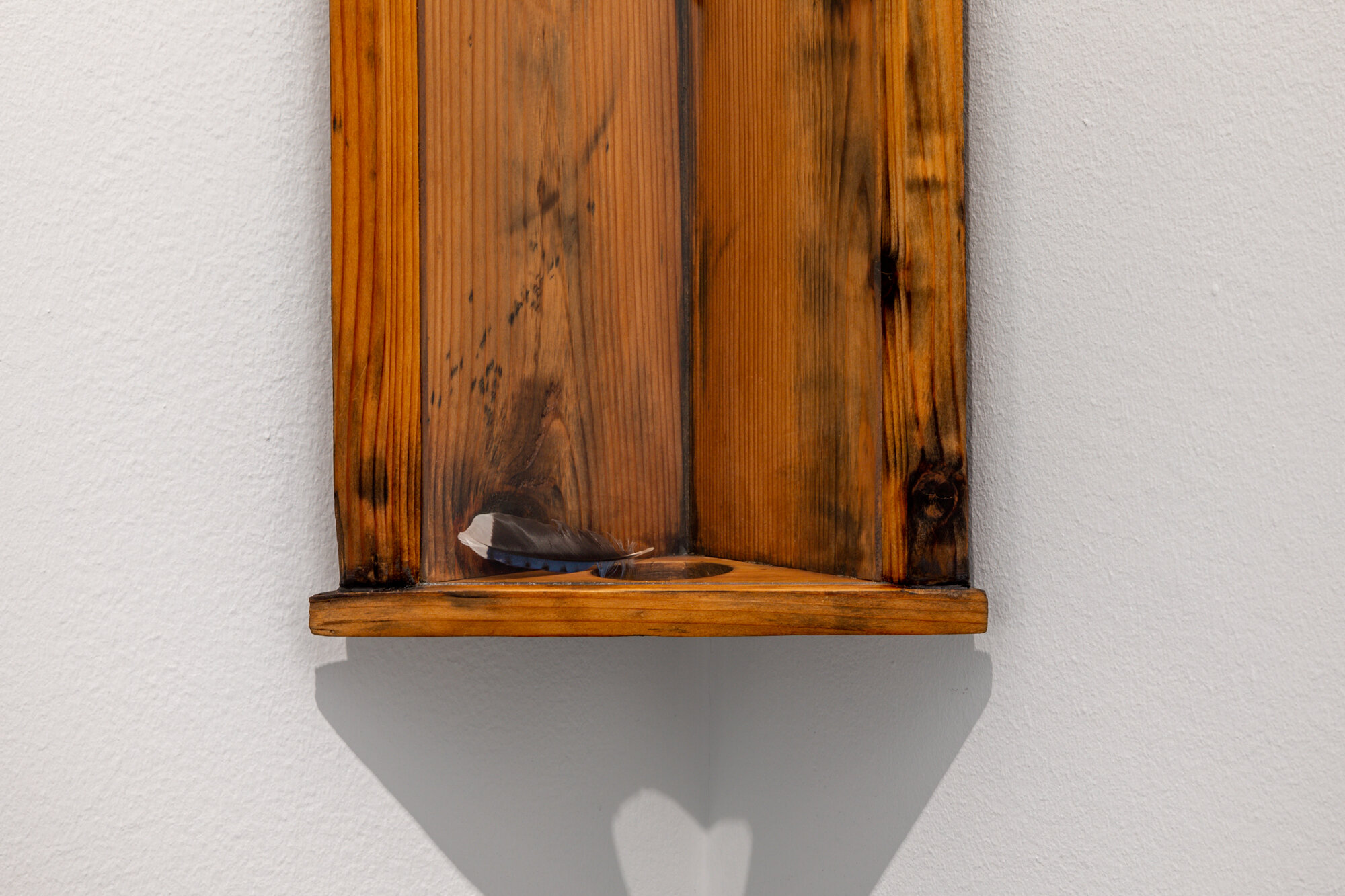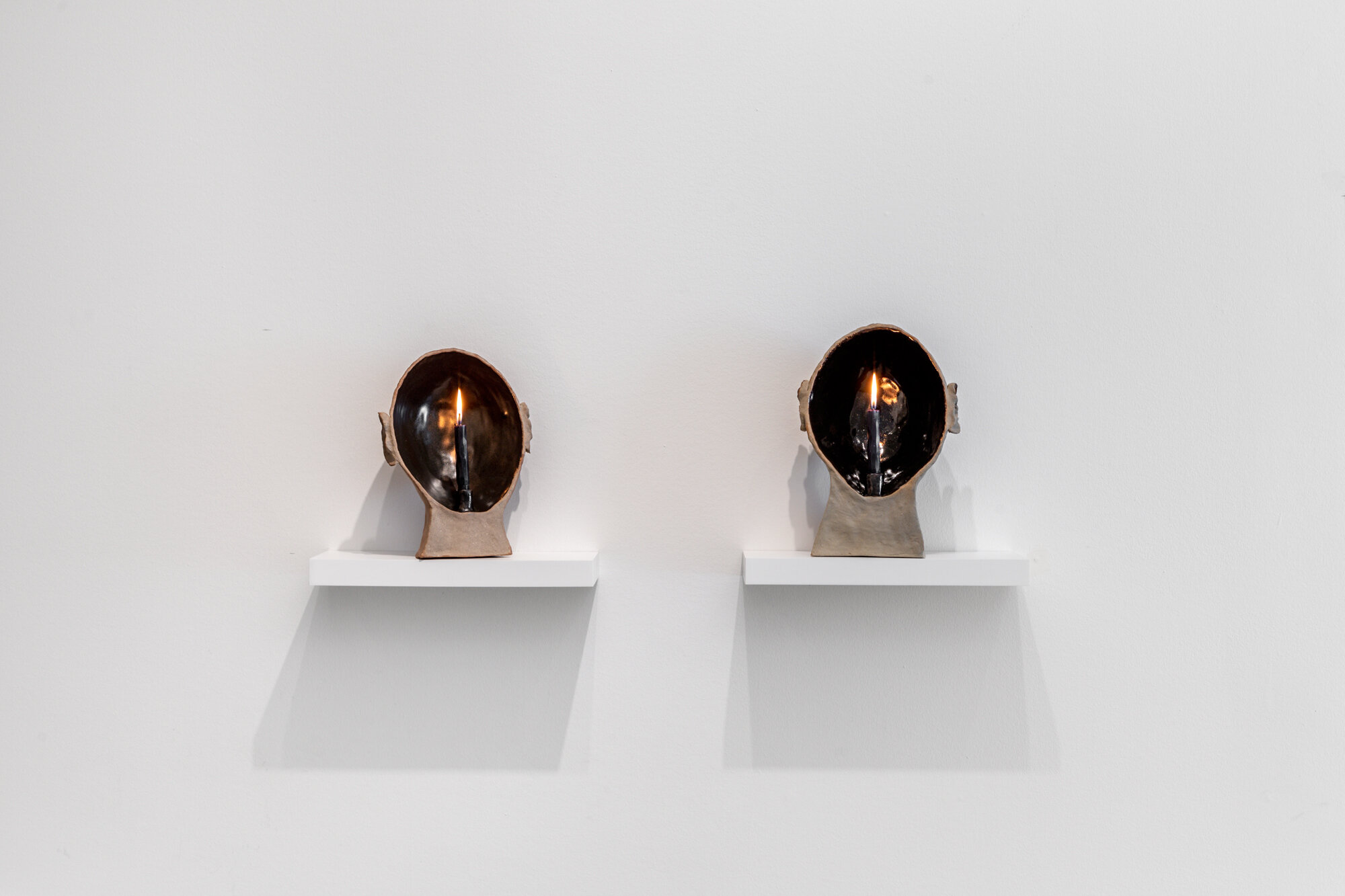Soo Shin
The Body of a Dreamer
February 2 - March 21, 2021
@
PATRON
673 N Milwaukee Ave
Chicago, IL 60642
Review by Gareth Kaye
I remember the first time I encountered Soo Shin’s work. It was at Bar 4000. Socks petrified into place with concrete on the floor; a mirror, smeared with some kind of dust or resin; a drawing; an obsidian black vessel with two larynxes thrust skywards and suspended from the ceiling on a steel table; and a plinth with small concrete balls rolled up and spread meticulously across in a grid, the show’s centerpiece: A Collection of Tears 2012 - Present. It was as if Shin had concrete on hand for any moment where the waterworks might get going and comingled the dusty aggregate and salty tears, ossifying them and the joys or pains that might have sparked them into a marker of their genesis like so much loose gravel kicked from the grooves of a work boot. I think about the show often and the way I felt after, excited that I might get to see more of this artist’s work in the future, and a little bit gutted too – is this not the same mixture of feelings felt when woken from a dream that feels inseparable, but far better than reality?
In her latest solo exhibition, and first with representation at PATRON, Shin’s The Body of a Dreamer expands on the artist’s relationship with the discontinuous nature of the individual, body, and time. The exhibition belies an artist who avoids simplistic ways of exploring the problematics of wholeness or a lack thereof. While the work could have benefited from some more square footage (there might even be one piece too many) in the occasionally claustrophobic rear gallery at Patron; it ended up profiting off the warm light and abundance of shadows produced by being sequestered away from the gallery’s large windows.
Shin’s approach to sculpture is deeply sensitive to materials and the ways in which they share in the burden of manufacturing meaning, and the artist’s choices recall a kindred sensibility to predecessors such as Joan Jonas, Mark Manders, and Josef Beuys. Warm wood, cold-rolled steel, the familiar intimacy of natural muslin, concrete, human hair, feathers, and the alien organicity of clay all play a pronounced role in taking static objects and imbuing them with an animism that sets the stage for the ‘dream’ Shin’s title evokes.
So, what does it mean to dream, really? Dreams seem even more potent after the explicit stagnation of daily life this last year (as opposed to the subtle and implicit misery that characterized every facet of the “Old Normal”). But where has a year of dreaming taken us? In a time where an actual break in the order of the world presented itself with space to dream of what a different world would look like dreamers shied away.
They say you are what you eat, and society, being fed so much slop from nostalgia’s compost bin seems to give the aphorism an air of infallible credence. Dreams usually are said to signify the potential for change, progress, or some kind of growth, but what do progress, and growth mean now that both terms are synonymous with the vampiric financialization sucking the life out of workers and the planet? In a world where life is confusing and unintelligible, it seems safer to turn our dreams inwards, towards something familiar and comforting, because when you wake up those things will be there, and life will be a dream. So how can we reconjure the spirit of the Future through dreams once more?
A dream is nothing without its comedown, and Shin’s sculptures seem to straddle this egress between the dream and reality, taking a hard look at the morning (or perhaps more honestly mourning) sickness that accompanies waking up from inhabiting a better alternative.
Throughout the show, there are moments nestled between the comfort and hope found in dreaming as well as the hard reality that a dream is also a set of actions suspended. The Body of a Dreamer (2020) and The Body of a Dreamer (Right Hand) (2021) present casts of the artist’s respective hands and a clay wing sit nestled into pockets on a muslin cloth suspended over a steel armature. While peddling a metaphor for actions performed by the hand as a site for dreams to “take flight” their disparate positioning on opposite sides of the cloth gives way to the resignation of eternally gesturing towards something simultaneously intrinsic to oneself, but also so distant. The wings, much like the hands are disembodied, bereft of their clay pigeon to be shot out of the sky, and perhaps this is the point? These moments of departure from the dream are a consistent line of trouble in Shin’s sculptures, which occupy the rift between two dilemmas: the allure of becoming new and the problem of discerning whether or not the pain and discomfort involved in transformation is worth it, or bearable.
It isn’t a matter of whether or not a dream of the new can be realized, but rather what is willing to be done on behalf of the dreamer to radically reorganize themselves in order to become or create something else. In To Leap (2021), two long treads of ebonized oak, terminate in the husk of two feet, positioned on the very front of their toes in a perpetual forward lurch. The edges of the feet are flayed and hollowed out on the inside from the impression left by the artist peeling the feet away from the body, while the oak is flocked in refuse metal dust from production. Unlike a balletic grande jete, To Leap is neither a gesture that finds liberation or defies gravity, rather it indicates that forward momentum is always followed by a trail of what is torn off and left behind, burdened by the things abandoned in a quest to go elsewhere. To become something new necessarily entails a shedding of the old, a peeling or more likely ripping that we are less likely to lose than drag behind ourselves for the rest of our lives, pinning the viability of the dream on whether or not it can shoulder the weight.
The body of the dreamer, the one who facilitates the conjuring of the new must be protected at all costs, as the trope in film and literature shows, the dreamer’s body is a vulnerable one, requiring protection by those who share their vision for change. The installation of work in Shin’s show creates an environment conducive to a kind of mythic dreaming, for instance, The Head (2020), a stoneware face whose visage has been effaced (save for the nose) as if the dreamer’s true face was being utilized wherever it is their consciousness is active. The otherwise sturdy head is supported between two cedar wedges that an errant foot walking through the installation would immediately jeopardize, placing the viewer in the context of those who may be the ones threatening the sleep of the dreamer. Additionally, on the opposite wall of the gallery nearest the door are Beacons (2021), two busts with a concave obsidian void where the face should be and filled with two candles that burn during the exhibitions open hours. The voids left behind where the face should be additionally function as mirrors, displacing the viewer’s face onto where the sculptures’ should be, while the candles mark the passage of time while the dreamer is away.
What will happen to the body of the dreamer while they are away? Will the metamorphoses be complete, or will it be left half-finished and bastardized, or maybe nothing will change at all? After all, it was only a dream. The Place Between Leaving and Staying (2021), is one of the most interesting works in the show, an undulating steel hoop seems to hover above the gallery floor, while gently placed across the top of the circle is a golden honeysuckle branch. The viewer would be forgiven for thinking a bird’s feather is also affixed to the work, but on closer inspection, it is strands of the artists hair fused to one of the branches. The combination between two disparate objects, yielding the illusion of a third points to the efficacy of metamorphoses and the chimerical potentials in shedding oneself to become new.
The work’s title, alluding to the impasse of transitioning between states of being – wakefulness and sleep, old and new, human and non-human this branch seems to not only belie a state change in being, but also wields talismanic potentials to instrumentalize and animate all the other pieces on display. With a wave of the branch, the hands cradled by muslin can easily become wings, and the dreamer’s head can regain its face and awake to report of what new possibilities it discovered during slumber. However, the hoop is bolted to the ground, and its weightlessness is an illusion, as is the alchemical transition of human to bird, but the sacrifice and shedding of what currently constitutes being is real and it is present, this is the first step in the decision to discover that which may indeed conjure the new.
Is a plan of action proposed by the work? Not necessarily, but if there was anything close to one it would be tucked away in the corner, hovering above the rest of the work. A Breath of Memory (Lauren’s Feather) (2021), was both my favorite and the work I found most frustrating in the exhibition. In a glass shadow box, housing the feather of a blue jay a friend of Shin's discovered while visiting a cemetery following the death of her father, the viewer is invited to crouch below the hole carved out in the bottom of the box and blow to lift the feather up, mimicking the wind that errantly blew this feather into the hands of Shin’s friend however long ago. It is a simple gesture, but one that recalls animistic traditions of embodying natural forces. I even briefly considered if the purpose of the honeysuckle stick with hair was to act as a fan, to bat it up and down beneath the hole and propel the feather into flight before it gently tumbles back down to earth. Throughout The Body of a Dreamer, there really is no leaving, no way out, at least not without plenty of reminders of what has been cut off, sacrificed, and deferred in favor of forward motion, which is a welcome alternative to the blind Capital acceleration that utilizes austerity measures to atrophy all those vital life connections that make living bearable. Guarding the feather against falling out is a thin mesh veil across the bottom of the hole, which left me frustrated on first pass – why not fully commit to the gesture of the wind, where what is caught in gust may be lost by it? But ultimately this safety net to preserve both the ritual and that which is precious, revives the idea of the sacred, something set apart not to be lost. After all, could not the pursuit of the new be characterized as the pursuit of sacred? According to the logic of Capital there is no sacred, nothing is off the table for commodification which is the profanation of the sacred. In this light, should not the pursuit of a different and better future redefine the sacred as those aspects of being that we are not willing to shed in the painful process of becoming new? To become ungovernable, as a way to slip free of such an elastic enemy as Capital, requires becoming unintelligible to the forces of power that be, but if we become unintelligible to ourselves and those who are with us in the struggle to imagine the future we might have succeeded in becoming new at the price of being left lost.
Installation Images: Soo Shin: The Body of a Dreamer, PATRON Gallery, Feb 2 - March 20, 2021

